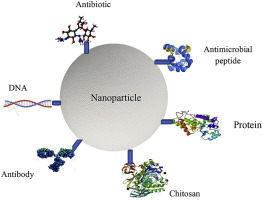Trends in Food Science & Technology ( IF 15.1 ) Pub Date : 2020-03-11 , DOI: 10.1016/j.tifs.2020.03.008 Akbar Bahrami , Rana Delshadi , Seid Mahdi Jafari

|
Background
Recently, the structural and behavioral changes of microorganisms have been rapidly increased. The appearance of resistant bacteria by enhancing antibiotic adaptation potentially is a significant concern for public health; thus, many efforts are needed to promote efficiency of antimicrobial substances. Surface functionalization of antimicrobial nanoparticles can improve their efficiency and diverse studies have shown their high potentials against resistant bacteria.
Scope and approach
The main objective of this study was to present an overview of the effect of surface functionalization of nanoparticles on their antimicrobial activities against resistant bacteria and discuss different types of functionalization methods for improving nanoparticle functions. The common functional compounds which can be applied on the surface of antimicrobial nanoparticle are described and the current application of functionalized nanoparticles in controlling high resistant bacteria are summarized and tabulated.
Key findings and conclusions
The surface functionalization of nanoparticles is an effective method in inhibition of the growth of various bacteria. Cationic polymers, small ligands, and biomolecules are the most popular functional compounds which have been successfully applied for improving the antimicrobial activities of nanoparticles through bonding with their surfaces. The changes in the surface characteristics of nanoparticles such as charge, shape, release behavior, and synergistic effects of functional agents on the nanoparticles can greatly enhance their antimicrobial efficiencies.
中文翻译:

通过表面功能化策略将抗菌纳米颗粒主动递送到微生物细胞中
背景
最近,微生物的结构和行为变化已迅速增加。通过增强抗生素适应性来产生抗药性细菌可能是公众健康的重要问题;因此,需要许多努力来提高抗菌物质的效率。抗菌纳米颗粒的表面功能化可以提高其效率,各种研究表明它们具有抵抗耐药细菌的巨大潜力。
范围和方法
这项研究的主要目的是概述纳米粒子的表面功能化对其抗药性细菌的抗菌活性的影响,并讨论改善纳米粒子功能的不同类型的功能化方法。描述了可用于抗菌纳米颗粒表面的常见功能化合物,并总结并列出了功能化纳米颗粒在控制高耐药细菌中的当前应用。
主要发现和结论
纳米粒子的表面功能化是抑制各种细菌生长的有效方法。阳离子聚合物,小的配体和生物分子是最流行的功能化合物,已成功应用于通过与纳米粒子的表面键合来改善纳米粒子的抗菌活性。纳米粒子表面特性的变化,例如电荷,形状,释放行为以及功能剂对纳米粒子的协同作用,可以极大地提高其抗菌效率。











































 京公网安备 11010802027423号
京公网安备 11010802027423号